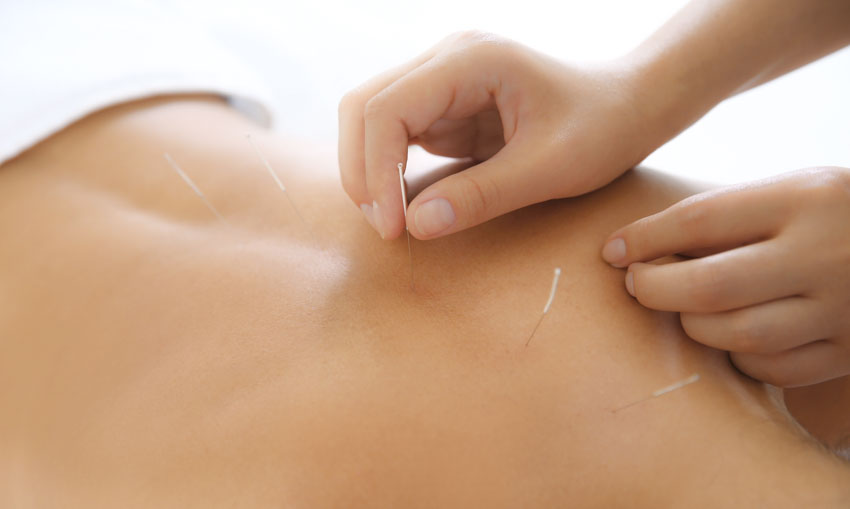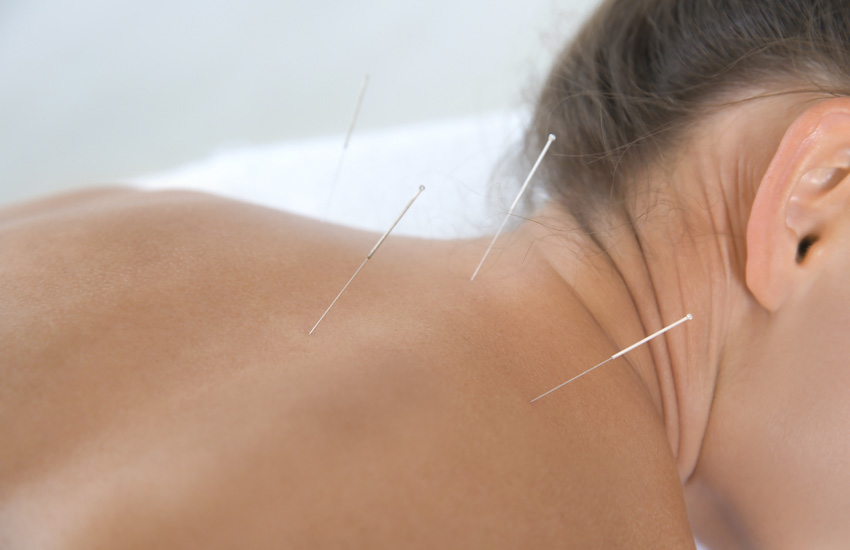Acupuncture news releases received a great deal of attention at HealthCMi this summer. The following are short excerpts taken from the HealthCMi summer top three list. The first in our top three is an article on the topic of acupuncture for the treatment of neck pain due to disc degeneration.
Neck Pain
Acupuncture is effective for the treatment of cervical spondylosis, a painful disorder caused by intervertebral disc degeneration (due to wear and tear of the discs in the cervical spine). The acupuncture point GV14 (Dazhui) was found effective across multiple studies for the treatment of cervical spondylosis. Based on the data, this acupuncture point is recommended for patients with cervical spondylosis. Shao et al. tested the efficacy of acupuncture using the following acupuncture points:
- GV14 (Dazhui)
- SI3 (Houxi)
- GV20 (Baihui)
- GB20 (Fengchi)
Acupuncture at Dazhui was perpendicularly inserted and moxa was added. Deqi was elicited at the other acupoints combined with electroacupuncture. Fengchi was connected to Houxi on the afflicted side and Fengchi was connected to Baihui on the healthy side with electrodes. Acupuncture was applied once per day, 5 times per week, for a total of 2 weeks as one course of treatment. The results indicate that 24 out of 25 cases improved significantly for a total effective rate of 96%. [1]
The remainder of this article covered more research finding GV14 effective for the treatment of neck pain due to disc degeneration. The next article garnered a great deal of attention. The research item presented acupuncture for the treatment of fibromyalgia, using both subjective and objective instruments to determine the results.
Fibromyalgia
Acupuncture is an effective treatment modality for patients with fibromyalgia. Researchers conclude that acupuncture improves two biochemical markers and subjective clinical outcomes for patients with fibromyalgia. Objective measures demonstrate that acupuncture increases serum serotonin levels and reduces Substance P levels. For subjective measurements, the researchers document enduring subjective improvements including less pain, fatigue, and anxiety. [2]
Fibromyalgia is a chronic condition with symptoms including pain, sleep problems, fatigue, and cognitive difficulties. Fibromyalgia frequently presents with depression and anxiety. The exact mechanism of the disease has not been fully identified within allopathic medicine, but it is posited that serotonin and Substance P play a significant role.
Serotonin is a neurotransmitter active with mood, sleep, sexual behavior, and pain regulation. Independent research confirms that fibromyalgia patients have lower serum serotonin levels than healthy individuals. Substance P is a neuropeptide involved in pain, depression, and neurogenic inflammation. [3] Excess Substance P levels may play a role in fibromyalgia pain perception.
The study measures levels of the biochemical markers along with several clinical changes, both before and after treatment with acupuncture. A total of 75 participants were recruited for the study. The patients were randomized into three groups; acupuncture, sham acupuncture, and simulated acupuncture. The following acupuncture points were administered in the study:
- Hegu (LI4)
- Quchi (LI11)
- Shenmen (HT7)
- Neiguan (PC6)
- Qihai (CV6)
- Taichong (LV3)
- Zusanli (ST36)
- Sanyinjiao (SP6)
- Dazhui (GV14)
- Jianzhongshu (SI15)
The article continues, demonstrating important aspects of acupuncture for the treatment of fibromyalgia. It is not unusual for patients to seek help with this condition from a licensed acupuncturist because it is non-nociceptive (i.e. the pain perception is not due to pain receptor activation). Often, medications cannot fully address the pain and fatigue levels and acupuncture has the ability to address both of these concerns.
The next research article finds acupuncture effective for the alleviation of pain during pregnancy. This is an important finding because the use of pain medications during pregnancy may be deleterious to the fetus.
Pregnancy Pain
Acupuncture and cupping are both safe and effective for the treatment of lumbopelvic pain during pregnancy. A hospital-based study at a community clinic in New Zealand finds that acupuncture produces important positive patient outcomes, including significant reductions in lumbopelvic pain levels. [4] Lumbopelvic pain is located at the lower torso, lower back, and pelvic girdle. Acupuncture is an important treatment option because a variety of common prescription drugs and over-the-counter analgesics are contraindicated during pregnancy.
A total of 245 pregnant women attended the New Zealand clinic, 144 (56.5%) reported lumbopelvic pain as their primary or secondary complaint. A total of 63 women were excluded from the study because they either did not complete a baseline assessment or did not complete a post-treatment follow-up. Data from 81 pregnant women were included in the results. Forty-five women were nulliparous (55.5%) and the majority of women were in the third trimester of pregnancy (49.3%). A total of 31 were in their second trimester (38.2%) and 10 were in the first trimester (12.3%). Most participants were referred to the clinic by a midwife (72%).
Treatment Approach
Acupuncture and cupping treatments were provided and points were selected on an individual basis and not all points were used on all of the women. The most commonly used points were Yanglingquan (GB34) and Zulinqi (GB41), which were used in over 50% of study participants. Ashi points on the lower back were used on 25–50% of participants, excluding needling of Ciliao (BL32) and Zhongliao (BL33). Ashi points surrounding Huantiao (GB30) and ashi points on, near, or between Qiuxu (GB40), Shenmai (BL62), and Taichong (LV3) were also used in 25–50% of participants. Ashi points between Neiting (ST44) and Lidui (ST45) and ashi points on, near, or between Chengshan (BL57), Feiyang (BL58), Yintang (MHN3), Baihui (GV20), Kunlun (BL60), Fengshi (GB31), and Waiguan (TB5) were used in fewer than 25% of participants. Cupping to the lower back was provided to over 50% of participants. This is an interesting selection given that cupping is ordinarily contraindicated on the abdomen and lower back during pregnancy.
Upon insertion of the needles, deqi was obtained manually and needles were retained for 20 minutes. Treatment was provided once per week, with each participant receiving a minimum of 3 treatments. The mean number of treatments was 3.85. Ear press needles were also offered to participants to be placed on foot acupoints. They were advised to retain these for 2–3 days and to remove them if they became uncomfortable.
Results and Discussion
All women taking part in the study completed the Measure Yourself Medical Outcome Profile (MYMOP) questionnaires prior to and after acupuncture treatments. The MYMOP questionnaire allowed the participants to describe and rate symptoms on a scale of 0–6. They were allowed to give additional information on other symptoms, especially those related to functional impairment and well-being.
Of the 81 participants, 18 reported an improvement in symptoms of 1–1.99 points (22.2%), 30 reported an improvement of 2–2.99 points (37.0%), 15 reported an improvement of 3–3.99 points (18.5%), and 9 reported an improvement of 4 or more points (11.1%). A total of 72 participants (88.9%) reported clinically significant improvements following treatments with acupuncture and cupping. The data demonstrates that acupuncture and cupping are effective for the relief of pain during pregnancy.
There’s the summer top three popular research articles, we hope you liked them. If you have questions regarding these topics, contact a local licensed acupuncturist to learn more.
References:
[1] Shao YX. Clinical study on treatment of vertebral artery type of cervical spondylosis with warm needling Dazhui [D]. Guangzhou: Guangzhou University of Traditional Chinese Medicine, 2008.
[2] Wolfe F. et al Serotonin levels, pain threshold, and fibromyalgia symptoms in the general population. The Journal of Rheumatology [01 Mar 1997, 24(3):555-559].
[3] Harrison S. Geppetti P. Substance P. The International Journal of Biochemistry & Cell Biology Volume 33, Issue 6, June 2001, Pages 555-576.
[4] Soliday E. Betts D. Treating Pain in Pregnancy with Acupuncture: Observational Study Results from a Free Clinic in New Zealand Journal of Acupuncture and Meridian Studies 2018;11(1):25e30.


